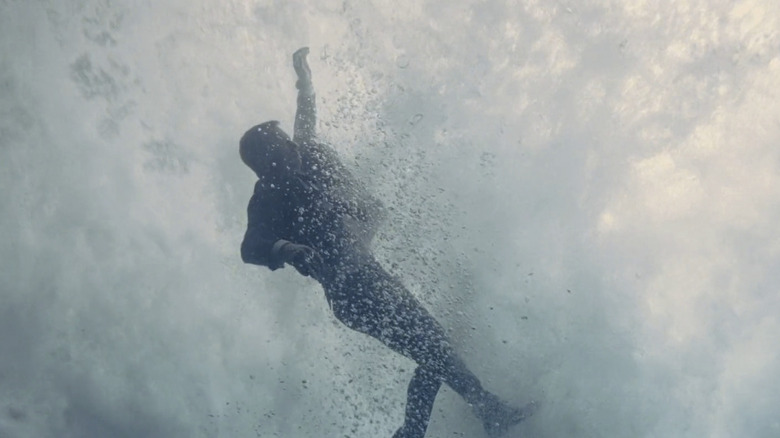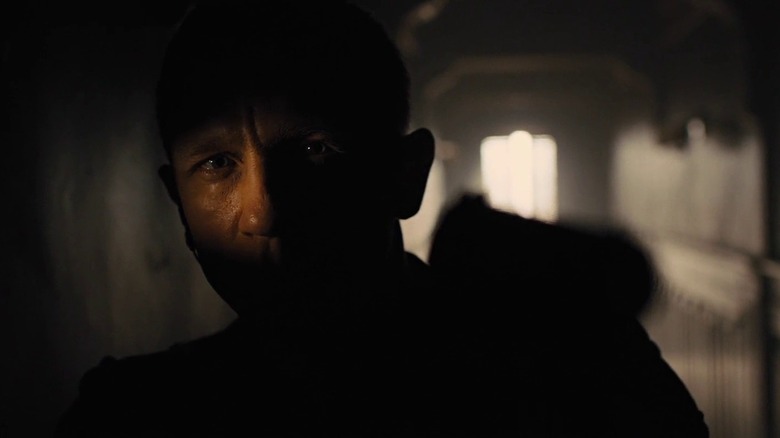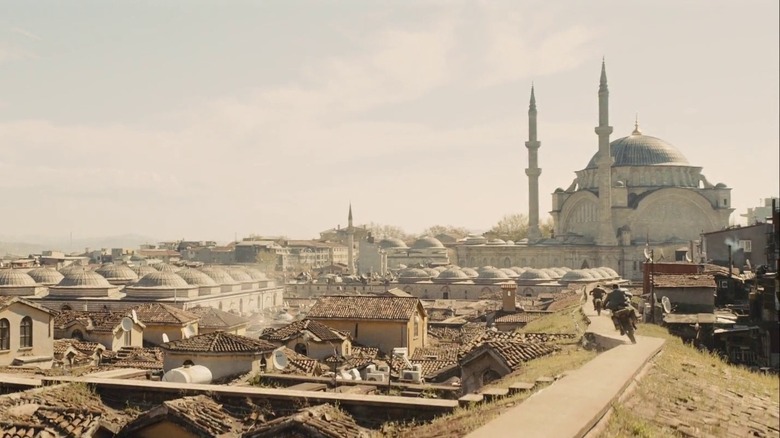One Third Of The Time Filming Skyfall Was Spent On The First 10 Minutes
The opening scenes of any film, especially an action blockbuster, are instrumental in establishing the tone and the pace audiences can expect from your movie. When you're crafting a new entry in a long cinematic legacy of James Bond movies, there's an even greater expectation to work against: nailing the franchise tradition of the cold open. Today is the 10th anniversary of the most beloved Bond outing of the Daniel Craig era, "Skyfall," and director Sam Mendes knew he wanted to accomplish everything he could with his ambitious entry into the 007 franchise.
Most Bond films usually begin with a cold-open unrelated to the central conflict of the film, mostly acting as a one-shot of sorts — establishing a new director's voice with the character before getting into the main course. In "Skyfall," Mendes delivers all the spectacle required of him: a gorgeous silhouetted opening shot courtesy of Roger Deakins, a motorcycle chase through Istanbul, Craig's Bond fistfighting his foes on top of a moving train while Moneypenny (Naomie Harris) is on the field trying to take a shot at Patrice (Ola Rapace) with her sniper.
When Bond is accidentally shot and falls off the train, Mendes is letting you know that "Skyfall" is not just your average 007 film. This is a cold open with a crucial dramatic beat and cliffhanger that will keep your attention as Adele belts the opening theme.
Of course, with so many moving pieces surrounding a crucial moment of vulnerability for Bond, Mendes wanted to perfect the sequence to every fine detail. In the director's commentary for "Skyfall" Mendes revealed that one-third of shooting was dedicated to the cold open of the film, taking perfectionism to a whole new extreme.
Balancing action and story
"We spent a long time conceiving this entire chase, I suppose we must have spent a third of the entire movie working on these first 10 minutes."
Of course, when you spend one-third of your shoot on a specific sequence, there's going to be excess. That's where film editing and the "cutting room floor" comes in. When the initial timeline was built for the cold open, it aired a little over 11 minutes, which Mendes describes as "right on the edge of being too long."
"We were very hard on anything that didn't seem necessary or outstayed its welcome, or in any way fetishized the action," Mendes explains over the cold open, "I think there's a great tendency to want things to be louder and faster and forget the story. Almost as if the story stops, the action begins, and the story doesn't start again until the action is over."
Mendes' feelings towards balancing action and story give some context as to why he chose to incorporate the cold open into the central plot of the film, as Bond's defeat and failure to secure the hard drive becomes a larger question of his own mortality, a running theme with Craig's Bond run. Mendes proves to be an economical filmmaker, even one minute off of ten is a detriment to the film's pace. If something can be established in a shorter time, that's definitely what's preferred.
A train stunt 'on the edge of insane'
Outside of perfecting all other elements of the scene, it was crucial to spend so much time on the opening sequence because the main element of this set piece involved Craig in one of the more dangerous stunts in his career, fighting on the moving train. Mendes shed some perspective on how harrowing it would have been to be in Craig's position:
"What you see here is Daniel on the train. It certainly surprised me on the day because he did some things here that are frankly on the edge of being insane. As they emerge under the tunnel, fistfighting on top of the train, he was connected by just a tiny little wire and nothing else. There's nothing but a massive drop below, and when you're standing on the train itself you can't see the bridge below. It really does feel like you're traveling in the air... I don't get vertigo, but I felt it standing on that train."
Craig had a stunt double on "Skyfall," but this specific scene involved seeing his actual face so much that he took a chance and handled the stunt himself. "He was magnificently brave and inspiring to the crew," Mendes said.
Whatever Mendes's motivations were, of perfectionism or out of set safety, dedicating a large portion of the shoot to the cold open certainly paid off. "Skyfall" has one of the more memorable introductions in the franchise from recent memory, and it's not just because of its thrilling action setpieces, but also because it finds something shockingly emotional in its large scale. Mendes delivered a sequence that satisfies the senses, but through subversion, reminds us that James Bond bleeds.


